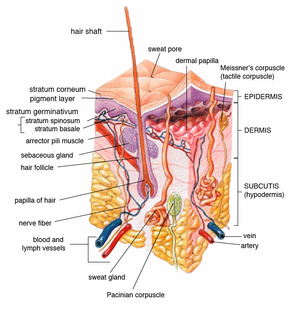Skin
The "Scots" that wis uised in this airticle wis written bi a body that haesna a guid grip on the leid. Please mak this airticle mair better gin ye can. |
| Skin | |
|---|---|
 A diagram o human skin. | |
| Details | |
| Identifiers | |
| Laitin | Cutis |
| TA | A16.0.00.002 |
| Anatomical terminology | |
Skin is the saft ooter tishie kiverin vertebrates.
Ither ainimal kiverins, sic as the arthropod exoskelet, hae different developmental oreegin, structur an chemical composeetion. The adjective cutaneous means "o the skin" (frae Laitin cutis, skin). In mammals, the skin is an organ o the integumentary seestem made up o multiple layers o ectodermal tishie, an gairds the unnerlyin muscles, banes, ligaments an internal organs. Skin o a different naitur exeests in amphibians, reptiles, an birds.[1] Aw mammals hae some hair on thair skin, even marine mammals lik whauls, dowphins, an porpoises that appear tae be hairless. The skin interfaces wi the environment an is the first line o defence frae freemit factors. For ensaumple, the skin plays a key role in pertectin the bouk against pathogens[2] an excessive watter loss.[3] Its ither functions are insulation, temperatur regulation, sensation, an the production o veetamin D folates. Severely damaged skin mey heal bi formin scaur tishie. This is whiles discoloured an depigmentit. The thickness o skin an aw varies frae location tae location on an organism. In humans for ensaumple, the skin locatit unner the een an aroond the eelids is the thinnest skin in the bouk at 0.5 mm thick, an is ane o the first auries tae shaw signs o agein sic as "craws feet" an wrunkles. The skin on the paums an the soles o the feet is 4 mm thick an is the thickest skin on the bouk. The speed an quality o wound healin in skin is promotit bi the reception o estrogen.[4][5][6]
Fur is dense hair.[7] Primarily, fur augments the insulation the skin provides but can an aw serve as a seicontar sexual chairactereestic or as camouflage. On some ainimals, the skin is verra haurd an thick, an can be processed tae creaut laither. Reptiles and fish have hard protective scales on their skin for protection, and birds have hard feathers, all made of tough β-keratins. Amphibian skin is nae a strang barrier, espeicially regairdin the passage o chemicals via skin an is eften subject tae osmosis an diffusive forces. For ensaumple, a frog sittin in an anesthetic solution wad be sedatit quickly, as the chemical diffuses throu its skin. Amphibian skin plays key roles in iveryday survival an thair ability tae exploit a wide range o habitats an ecological condeetions.[8]
References[eedit | eedit soorce]
- ↑ Alibardi L (2003). "Adaptation to the land: The skin of reptiles in comparison to that of amphibians and endotherm amniotes". J Exp Zoolog B Mol Dev Evol. 298 (1): 12–41. doi:10.1002/jez.b.24. PMID 12949767.
- ↑ Proksch E, Brandner JM, Jensen JM (2008). "The skin: an indispensable barrier". Exp Dermatol. 17 (12): 1063–72. doi:10.1111/j.1600-0625.2008.00786.x. PMID 19043850.
- ↑ Madison KC (2003). "Barrier function of the skin: "la raison d'être" of the epidermis" (PDF). J Invest Dermatol. 121 (2): 231–41. doi:10.1046/j.1523-1747.2003.12359.x. PMID 12880413.
- ↑ Thornton MJ (2002). "The biological actions of estrogen in skin" (PDF). Experimental Dermatology. 11: 487–502. doi:10.1034/j.1600-0625.2002.110601.x.
- ↑ Gillian S. Ashcroft; Teresa Greenwell-Wild & Mark W. J. Ferguson (1999). "Topical Estrogen Accelerates Cutaneous Wound Healing in Aged Humans Associated with an Altered Inflammatory Response". The American Journal of Pathology. 155 (4): 1137–1146. doi:10.1016/S0002-9440(10)65217-0. PMC 1867002. PMID 10514397. Cite uses deprecated parameter
|last-author-amp=(help) - ↑ Desiree May Oh, MD, Tania J. Phillips, MD (2006). "Sex Hormones and Wound Healing". Wounds.CS1 maint: multiple names: authors leet (link)
- ↑ "fur". Retrieved 4 Mairch 2017 – via The Free Dictionary.
- ↑ Clarke, BT (1997). "The natural history of amphibian skin secretions, their normal functioning and potential medical applications". Biological Reviews of the Cambridge Philosophical Society. 72 (3): 365–379. doi:10.1017/s0006323197005045. PMID 9336100.
